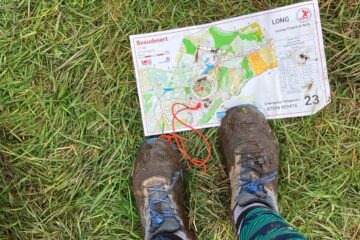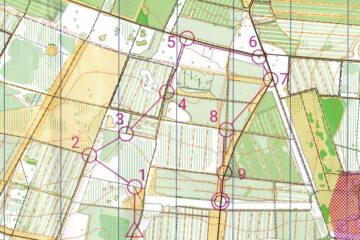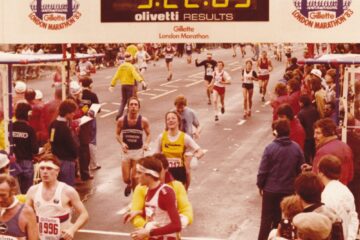The last time the Olympic Games were in Tokyo I was 12, and I had an important role to play in handing out chocolate to our returning track and field athletes. Here are some of the Olympic highlights that have shaped my love of sport.
I’m an almost-leap-year baby. I missed out on being born on 29 February by about 45 minutes but made up for it by getting married on that day 28 years later. I still get excited when the year is divisible by four. I love track and field athletics – I was just five when my father first took me to the White City stadium to watch athletes like Gordon Pirie, Derek Ibbotson*, Ron Clarke and Herb Elliott circling the old cinder track.
There was always so much going on. While distance runners were on the other side of the stadium, other athletes were jumping and throwing. I yearned to be the person who rang the bell for the last lap of the distance events. I saw it all in real life, in colour, before we even had a television. Athletics was the reason we got a television. In 1960 Daddy went to Robinson Rentals and signed a short-term rental agreement. “It’s going back after the Games!” he said, confidently. Of course it didn’t.
1960: Rome
Great Britain’s only athletics medal in the Rome games came from Don Thompson in the 50km walk. Racewalking looks funny anyway, but with his head on one side, dark glasses and a sun hat his mum had crafted by sewing a white handkerchief to the back of a cap, he looked very quirky indeed. The Italians loved him and called him Topolino – “mighty mouse”
A few months later he took part in a road race that came past our house! This was a big deal for the eight-year-old me.
1964: Tokyo
As an active member of the Amateur Athletic Association Club, my father was part of the Heathrow welcoming committee for incoming athletes. Very early in two mornings we travelled almost the full length of the Piccadilly line to Hounslow West and caught the bus to the airport. Daddy worked for Nestlé and had arranged for every athlete to have a large box of Home Assortment chocolates. It was my job to pass boxes from the table to the presenting dignitaries. Recipients included Lynn ‘the leap’ Davies (gold, long jump), Mary Rand (gold, long jump; silver, pentathlon), and Ann Packer (gold, 800m; silver, 400m).

1968: Mexico City
Technology was marching on. Our black and white rental TV was replaced by a colour model; the cinder track was replaced by a 3M innovation called ‘Tartan track’. This was, to my disappointment, not in the colours of Hunting Stewart or Dress Campbell.
In the field, Dick Fosbury introduced a whole new way of high jumping called the ‘Flop’. Dropping back-first into the school sandpit wasn’t a good idea, though, so we were still limited to ‘Straddle’ or ‘Western Roll’. So I was excited to go on a school outing to Crystal Palace and back flip several times into a deep trough of foam.
Bob Beamon broke the world long jump record by 55cm. His record of 8.9 metres stood for 23 years. He didn’t know he’d won at first because they gave him the result in metric and he was still jumping in feet and inches.
Team GB’s track sensation was David Hemery in the 400m hurdles. David Coleman, whose commentating gaffes were later given a column of their own in Private Eye, shouted “And who cares who’s third?” GB’s John Sherwood cared – he was the bronze medallist!
1984: Los Angeles
Fast forward to 1984, by which time you could fast forward and back. The colour TV had a new companion – a VHS recorder. With a time difference of eight hours between London and Los Angeles this was to become a huge asset, and not just for a good night’s sleep.
By this time I was working for Running magazine. My editor Andy was in Los Angeles filing his copy by telex. Even the now obsolete fax machine hadn’t made an appearance by then. In the London office we sat patiently waiting, and waiting some more, for the little machine to spring to life and print red capitals on paper. Much of his copy just went up to the great newsdesk in the sky, with Andy frantically chasing it by telephone.
With blank pages to fill, we turned to the TV and the new video technology. We did watch some of it live – most notably the 800m, which was built up as a rematch between Steve Ovett and Seb Coe. In Moscow 1980, Coe was favourite for the 800m but beaten by Ovett; and vice versa in the 1500m.
In the end Joaquim Cruz of Brazil took the honours in the 800m while Coe (with Steve Cram nipping at his heels) successfully defended the 1500m.
It’s hard to believe that until LA the longest running event for women was the 1500m. The marathon and the 3000m for women were added to the programme. Joan Samuelson won the first marathon, while in the 3000m Mary Decker crashed out dramatically after a collision with Zola Budd. Team GB’s Wendy Sly took the silver medal, but all media eyes were on the tearful Decker.
So we had plenty to fill our blank pages, but it was a close-run thing.
Next up: Super Saturday and Spotty Bridge: my experience of London 2012.
*Derek Ibbotson is a useful name to have in your trivia memory to answer the question “Who ran the first four-minute mile?” Roger Bannister was the first to do it in under four minutes in 1954 but Ibbotson was the first to clock exactly 04:00:00, in 1958.
Play > Tokyo Melody > Helmut Zacharias
Image by Gerd Altmann from Pixabay



2 Comments
Christine Lindop · 1 August 2021 at 10:55 am
Great read Ali! I’m sitting on the platform at Exeter St David’s on my way home from Jenny Bassett’s. Lots of reminiscing there too Look forward to the next installment.
Rob · 1 August 2021 at 11:56 am
I enjoyed reading this. Big events – Olympics, world cups, test match series – are also a central part of the sport-track of my life. I’m often able to link where I was, who I was with, in the same way as we do with music. I try and go to live events, and to play sport myself (but not quite at Olympic level!) Great life memories, interlaced of course with sadness and loss.